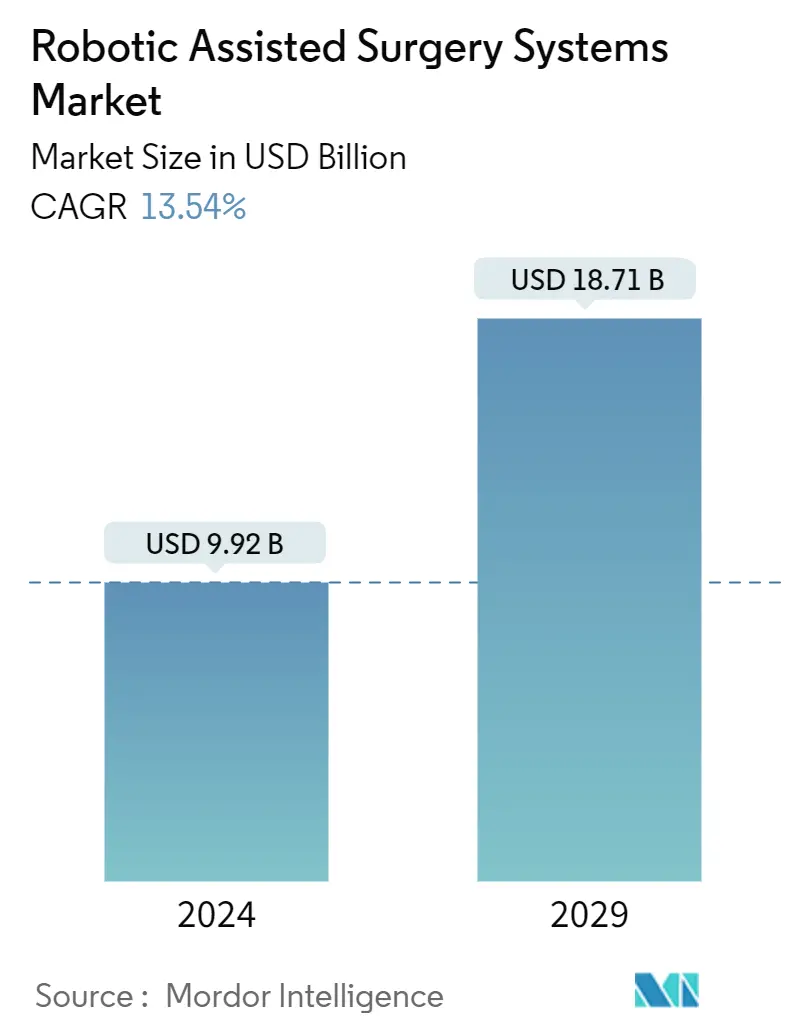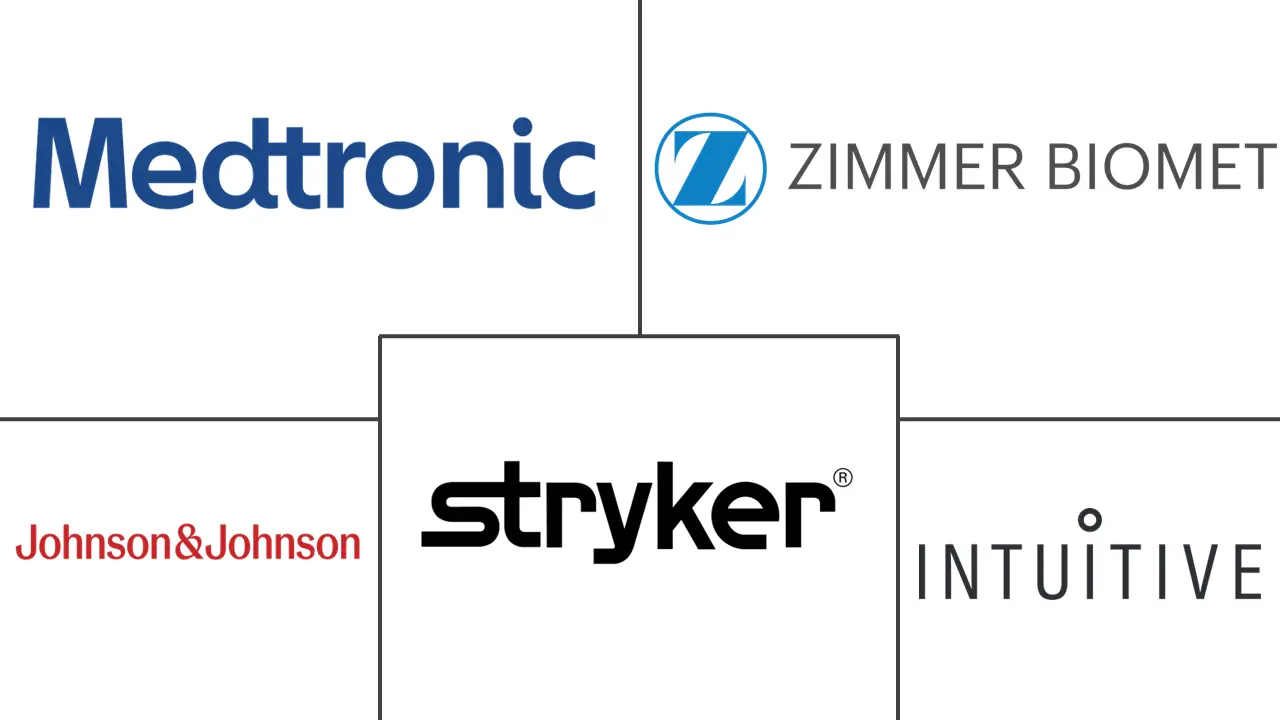Market Size of Robotic Assisted Surgery Systems Industry

| Study Period | 2021 - 2029 |
| Market Size (2024) | USD 9.92 Billion |
| Market Size (2029) | USD 18.71 Billion |
| CAGR (2024 - 2029) | 13.54 % |
| Fastest Growing Market | North America |
| Largest Market | Asia Pacific |
| Market Concentration | Low |
Major Players
*Disclaimer: Major Players sorted in no particular order |
Robot-assisted Surgical Systems Market Analysis
The Robotic Assisted Surgery Systems Market size is estimated at USD 9.92 billion in 2024, and is expected to reach USD 18.71 billion by 2029, growing at a CAGR of 13.54% during the forecast period (2024-2029).
Factors such as rising technological advancements, entry of new market players, and increasing cases of chronic diseases are propelling the growth of the Surgical Robotics Market.
The latest technological advancements in Medical Robotic Systems have demonstrated enhanced dexterity and precision. These advancements include improved articulation, tremor filtration, visualization, and haptic feedback, enabling surgeons to conduct intricate procedures with unparalleled accuracy and minimal tissue damage. Improved visualization and navigation, such as with Surgical Navigation Systems, are critical to technological progress in Robotic Surgical Procedures. High-definition 3D cameras and augmented reality overlays offer surgeons an immersive view of the surgical field, enhancing spatial awareness and decision-making capabilities.
For instance, in February 2023, CK Birla Hospital introduced fully active robotic technology for minimally invasive knee replacement surgery in India. This Robotic Surgery System is capable of 3D pre-planning, accurate assessment of deformities, and precise surgical results for exceptional patient outcomes. This technology was introduced to address the growing orthopedic burden by leveraging medical technology to ensure better patient care through improved diagnosis and precise results.
Moreover, established players are facing heightened competition from new entrants. These bring innovative technologies and disruptive pricing models to the market. For instance, in January 2024, CMR Surgical announced plans to launch cutting-edge technologies for Versius, focusing on vision, instrumentation, and digital enhancements. The company also aims to enter new markets, emphasizing its commitment to advancing surgical technologies and expanding its global presence in 2024.
Furthermore, the increasing cases of chronic diseases contribute to the growth of the Robotic Surgery Market. For instance, a report from the World Health Organization in February 2024 highlighted that there were over 20 million new cancer cases worldwide, with 53.5 million individuals surviving at least five years post-diagnosis. Lung cancer was the most prevalent, accounting for 12.4% of new cases, followed closely by female breast cancer (11.6%), colorectal cancer (9.6%), prostate cancer (7.3%), and stomach cancer (4.9%). The rising incidence and survival rates of complex cancer cases are driving demand for advanced surgical solutions, as Robotic Surgical Systems enable precision and minimally invasive procedures critical for improving patient outcomes in oncologic surgeries.
Therefore, owing to the aforementioned factors, such as the rising preference for minimally invasive surgery, increasing Robotic Surgical Procedures, and rising launches by market players, the studied market is anticipated to grow over the analysis period, contributing to the overall Robotic Surgery Market Growth. However, the stringent regulatory processes and high cost of devices are expected to restrain the market growth.
Robot-assisted Surgical Systems Industry Segmentation
Performing operative procedures with the assistance of robotic technology is referred to as robotic-assisted surgeries. A robotic system ensures precision and is used for remotely controlled, minimally invasive procedures. The current systems comprise computer-controlled electromechanical devices that work in response to controls manipulated by surgeons.
The robotic-assisted surgery systems market is segmented by product type, application, end users, and geography. The product type is further segmented into systems, consumables and accessories, and software and services. The application segment is further divided into gynecological surgery, cardiovascular, neurosurgery, orthopedic surgery, laparoscopy, urology, and other applications. The end user segment is further divided into hospitals, ambulatory surgery centers, and other end users. The geography segment is further segmented into North America, Europe, Asia-Pacific, Middle East, and Africa, and the Rest of the World. The market report also covers the estimated market sizes and trends for 17 countries across major regions globally. The report offers values (in USD) for the above segments.
| By Product Type | ||||
| ||||
| Consumable and Accessories | ||||
| Software and Services |
| By Application | |
| Gynecological Surgery | |
| Cardiovascular | |
| Neurosurgery | |
| Orthopedic Surgery | |
| Laparoscopy | |
| Urology | |
| Other Applications (thyroidectomy, parathyroidectomy, among others) |
| By End-User | |
| Hospitals | |
| Ambulatory Surgery Centers | |
| Other End-Users (surgical specialty clinics, academic and research institutes, among others) |
| Geography | ||||||||
| ||||||||
| ||||||||
| ||||||||
| ||||||||
|
Robotic Assisted Surgery Systems Market Size Summary
The robotic-assisted surgery systems market is poised for significant growth, driven by the increasing preference for minimally invasive surgeries and the rising adoption of robotic-assisted procedures. The market has shown resilience following the initial setbacks caused by the COVID-19 pandemic, with a steady recovery as surgical procedures resumed globally. The advantages of robotic-assisted surgeries, such as reduced pain and quicker recovery times compared to open surgeries, are propelling market expansion. Additionally, advancements in AI-powered robotic technologies are enhancing the safety and efficiency of surgical procedures, further boosting market growth. The high prevalence of chronic diseases, including cancer and cardiovascular conditions, is also contributing to the demand for precise and less invasive surgical solutions, thereby supporting the market's upward trajectory.
North America is expected to be a key region for growth in the robotic-assisted surgery systems market, fueled by the high burden of chronic diseases and technological advancements in surgical robotics. The region's market growth is supported by strategic initiatives from key players, including product launches and regulatory approvals, which are expanding the availability and adoption of robotic-assisted surgeries. The fragmented nature of the market, with numerous international and local players, is fostering competition and innovation, leading to the development of advanced surgical robots. As hospitals and healthcare institutions increasingly adopt these technologies to improve patient outcomes, the market is anticipated to experience robust growth over the forecast period.
Robotic Assisted Surgery Systems Market Size - Table of Contents
-
1. MARKET DYNAMICS
-
1.1 Market Overview
-
1.2 Market Drivers
-
1.2.1 Rising Technological Advancements and Entry of New Market Players
-
1.2.2 Increasing Cases of Chronic Diseases and Rising Preference for Minimally Invasive Surgeries
-
-
1.3 Market Restraints
-
1.3.1 Stringent Regulatory Processes and High Cost of Devices
-
-
1.4 Industry Attractiveness - Porter's Five Forces Analysis
-
1.4.1 Bargaining Power of Buyers/Consumers
-
1.4.2 Bargaining Power of Suppliers
-
1.4.3 Threat of New Entrants
-
1.4.4 Threat of Substitute Products and Services
-
1.4.5 Intensity of Competitive Rivalry
-
-
-
2. MARKET SEGMENTATION (Market Size by Value - USD)
-
2.1 By Product Type
-
2.1.1 System
-
2.1.1.1 Surgical Robot
-
2.1.1.2 Navigation System
-
-
2.1.2 Consumable and Accessories
-
2.1.3 Software and Services
-
-
2.2 By Application
-
2.2.1 Gynecological Surgery
-
2.2.2 Cardiovascular
-
2.2.3 Neurosurgery
-
2.2.4 Orthopedic Surgery
-
2.2.5 Laparoscopy
-
2.2.6 Urology
-
2.2.7 Other Applications (thyroidectomy, parathyroidectomy, among others)
-
-
2.3 By End-User
-
2.3.1 Hospitals
-
2.3.2 Ambulatory Surgery Centers
-
2.3.3 Other End-Users (surgical specialty clinics, academic and research institutes, among others)
-
-
2.4 Geography
-
2.4.1 North America
-
2.4.1.1 United States
-
2.4.1.2 Canada
-
2.4.1.3 Mexico
-
-
2.4.2 Europe
-
2.4.2.1 Germany
-
2.4.2.2 United Kingdom
-
2.4.2.3 France
-
2.4.2.4 Italy
-
2.4.2.5 Spain
-
2.4.2.6 Rest of Europe
-
-
2.4.3 Asia-Pacific
-
2.4.3.1 China
-
2.4.3.2 Japan
-
2.4.3.3 India
-
2.4.3.4 Australia
-
2.4.3.5 South Korea
-
2.4.3.6 Rest of Asia-Pacific
-
-
2.4.4 Middle East and Africa
-
2.4.4.1 GCC
-
2.4.4.2 South Africa
-
2.4.4.3 Rest of Middle East and Africa
-
-
2.4.5 South America
-
2.4.5.1 Brazil
-
2.4.5.2 Argentina
-
2.4.5.3 Rest of South America
-
-
-
Robotic Assisted Surgery Systems Market Size FAQs
How big is the Robotic Assisted Surgery Systems Market?
The Robotic Assisted Surgery Systems Market size is expected to reach USD 9.92 billion in 2024 and grow at a CAGR of 13.54% to reach USD 18.71 billion by 2029.
What is the current Robotic Assisted Surgery Systems Market size?
In 2024, the Robotic Assisted Surgery Systems Market size is expected to reach USD 9.92 billion.

